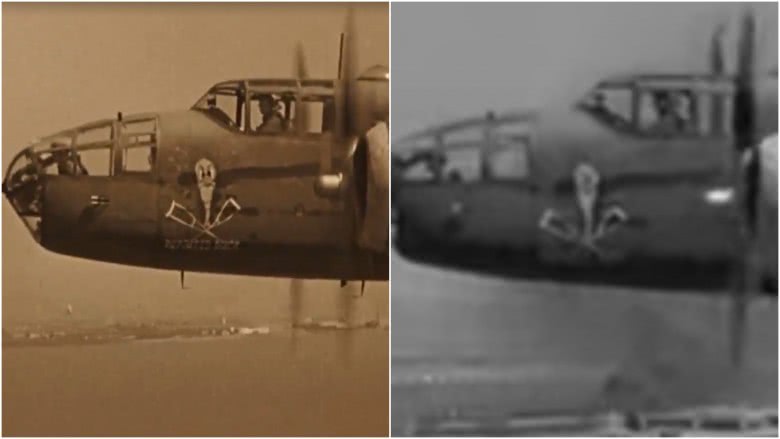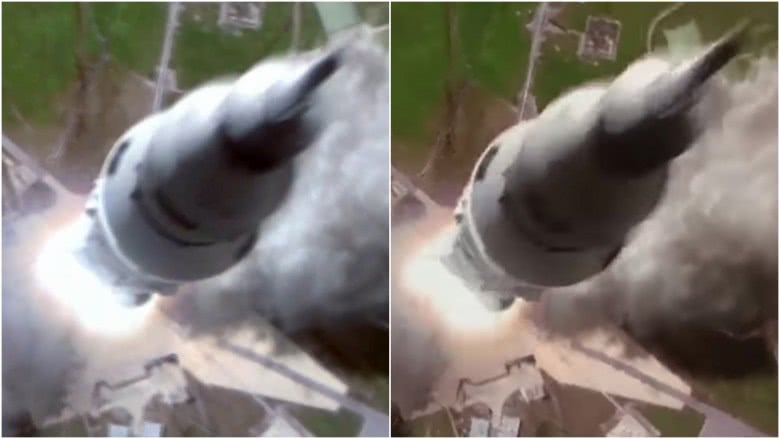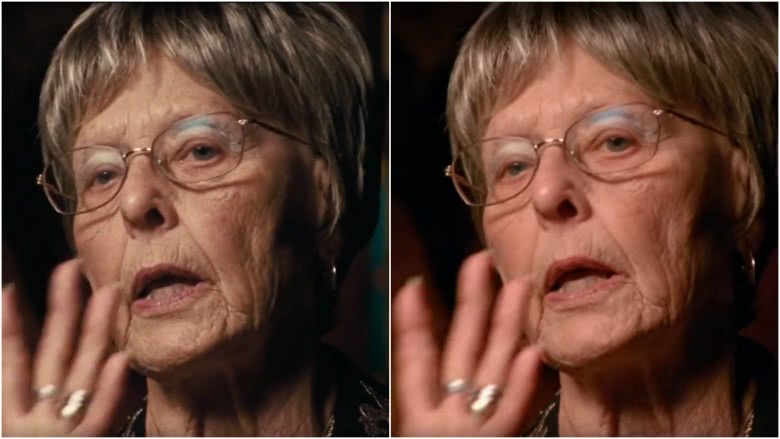Movies Caught Reusing Footage From Other Movies
We all know Hollywood loves to recycle ideas. In fact, while we often don't realize it, studios sometimes even reuse footage—from old installments in the same franchise as well as completely unrelated movies. Let's take a look back at some of the most surprising examples of filmmakers recycling parts from another movie.
Life and Spider-Man 3
The idea of using stock footage in multiple movies is nothing new; it's like using stock photos for multiple news articles. But we received an unexpected reminder when someone discovered that a scene in a TV spot for the 2017 science fiction film Life is actually taken straight out of Sam Raimi's Spider-Man 3.
The scene in question appears about 34 minutes into Spider-Man 3, with people looking up at Gwen Stacy hanging off the edge of a building, shortly before Spider-Man comes and rescues her. A slightly altered version of the scene appeared around the 26-second mark in a TV spot for Life—and never even made it into the final cut. It's just B-roll footage used for the commercial. The decision to reuse the footage probably came from someone in Columbia Pictures' marketing department—a division of Sony Pictures, the studio that produced and distributed Spider-Man 3.
Considering that Venom—a sentient alien symbiote—was one of the villains in the Spider-Man film, fans of the superhero franchise have begun to speculate a possible connection between the two films. What if the organism in Life is actually the Venom symbiote that appears in Spider-Man 3? That's a twist worthy of M. Night Shyamalan.
Transformers: Dark of the Moon and The Island
Recycling doesn't bother Michael Bay—he's guilty of reusing several scenes from some of his older films, and often does it so seamlessly that it's difficult to tell. One of the more recent examples can be spotted in Transformers: Dark of the Moon.
The third Transformers movie includes a car chase scene on a freeway—which includes a portion of another car chase sequence Bay had previously filmed for his 2005 release The Island. Instead of having bounty hunters chasing the good guys, though, Bay replaced them with Decepticons.
The inclusion of The Island's sequence may have been due to the studio wanting to limit liability. The Dark of the Moon set was particularly accident-prone. The first major accident left an extra permanently brain damaged and partially paralyzed due to a snapped steel cable. Then a second accident occurred a month later, when the Camaro that portrays Bumblebee collided with a police SUV, injuring both drivers. At that point, someone may have gotten the bright idea to just use a car chase from another movie.
Rogue One and A New Hope
In the original Star Wars, the Rebel Alliance destroyed the Death Star after obtaining the space station's blueprints and discovering its fatal design flaw: an open exhaust port. The reason for the vulnerable opening, as well as the way the Rebels obtained the Death Star plans in the first place, became the basis for Rogue One, Lucasfilm's first Star Wars anthology film.
Rogue One's story unfolds days before the events of A New Hope, and ends mere moments before the original film begins. To give the impression that the film is a prequel to Episode IV, director Gareth Edwards worked with ILM to digitally recreate Peter Cushing and Carrie Fisher's likenesses—but they didn't stop there. The filmmakers also brought back Gold Leader Dutch Vander and Red Leader Garven Dreis (played by Angus MacInnes and Drewe Henley, respectively).
Edwards, offered access to the Lucasfilm vault, found old and archived footage from A New Hope for the duo. They even had MacInnes record new dialogue specifically for Rogue One. Still, it was a gamble. Edwards was skeptical about using the old footage at first, but when the two Rebel leaders appeared on screen during Rogue One's premiere, the audience cheered. "It was the only time during the premiere where I actually punched the air," Edwards told Radio Times.
Transformers and Pearl Harbor
Throwing $150 million into a summer blockbuster movie based on a toy line would have been enough to put any studio on edge, so it's understandable that when he was filming the original Transformers, director Michael Bay cut corners by reusing a piece of footage of an aircraft carrier from Pearl Harbor. While making Harbor in 2000, Bay used the USS Lexington to represent the USS Hornet as well as a Japanese carrier; instead of shooting another scene using one of the Navy's carriers, Bay just recycled his old footage. Definitely cheaper than arranging a whole new shot.
Blade Runner and The Shining
Looking back on his experiences making Blade Runner, director Ridley Scott told the Hollywood Reporter that his investors were dissatisfied with the original ending, so he had to change it. "[They] were giving me a really hard time, saying 'You can't end the film with picking up a piece of origami, looking at the girl, walk in the elevator, nod, and bingo that's it.' I said, 'It's called a film noir.' And they said, 'What's a film noir?' That was a big problem." They wanted Scott to film an ending with Rachael and Deckard heading off into the wilderness, which he thought was ridiculous. "I said, 'Well if they go off into a beautiful wilderness, why do they live in this dystopian environment?'"
Scott had a point, but he wanted to please his investors, so he redid the ending anyway, giving them the uplifting ending in the wilderness—but he didn't shoot the footage himself. "By then I had talked to Stanley [Kubrick] a few times. I said, 'I know you shot the hell out of The Shining, can I have some of the stuff?' So at the end of the film in Blade Runner, that's Stanley Kubrick's footage." Kubrick apparently shot 17 hours worth of footage from a helicopter while compiling aerial shots for The Shining, much of which never saw the light of day. It only made sense for Scott to borrow some of it for Blade Runner.
Midway and numerous movies
The Battle of Midway, fought during June 1942 in the Midway Atoll in the Pacific Theater, proved a turning point in World War II. More than 30 years later, director Jack Smight honored its importance with Midway, an epic drama featuring a star-studded cast that included Charlton Heston, Henry Fonda, Glenn Ford, and Toshiro Mifune.
Prior to the advancement of digital effects, it couldn't have been easily filming the necessary scenes for a movie like Midway. To keep costs down, many of its action scenes from earlier movies such as Tora! Tora! Tora!, Away All Boats, Thirty Seconds Over Tokyo, and the documentary The Battle of Midway. The filmmakers even extracted scenes from the Japanese film Hawai Middouei daikaikusen: Taiheiyo no arashi, also starring Mifune.
Austin Powers: The Spy Who Shagged Me and Apollo 13
When one movie uses footage from another, they're usually similar in some way. But there's nothing even remotely alike between the Mike Meyers-starring Austin Powers: The Spy Who Shagged Me and the Oscar-winning Apollo 13. Those two films ordinarily wouldn't find their titles uttered in the same sentence—except for one scene in particular.
In Austin Powers, Mini-Me escapes with Dr. Evil to his Moon Base at the end of the movie. To capture him, Austin and Felicity hitch a ride on Apollo 11 (yes, the Apollo 11) along with one of NASA's astronauts, and if the whole sequence seems out of place, that's because it is. An eagle-eyed viewer noticed that it was taken right out of Ron Howard's Apollo 13, a sequence created by Academy Award-winning visual effects designer Robert Legato, who received an Oscar nomination for Best Visual Effects for his work.
Beauty and the Beast and Sleeping Beauty
Live-action filmmakers aren't the only ones who recycle footage. Sometimes, animators reuse scenes too—just as Disney did with their smash 1991 hit Beauty and the Beast.
A dance sequence between Princess Aurora and Prince Adam in Disney's 1959 classic Sleeping Beauty was recreated, frame by frame, for Beauty and the Beast's dance between Belle and Prince Adam, with animators changing the background as well as the characters. It wasn't the first time Disney dipped into its own vaults to repurpose older animation, either—in the '70s, they also reused an animation sequence from Snow White and the Seven Dwarves for Robin Hood.
Back to the Future Part II and Back to the Future
While the majority of actors in Robert Zemeckis' Back to the Future played older versions of themselves in Back to the Future Part II, not everyone could make the journey to the future. Claudia Wells, who played Marty McFly's girlfriend in the first movie, couldn't commit to filming the two Back to the Future sequels back-to-back due to her mother's ill health, so the filmmakers replaced her with Elisabeth Shue. They also need to replace Crispin Glover, who played Marty's dad—a process that didn't go anywhere near as smoothly.
Glover reportedly didn't like the script, and chose not to return for the sequel unless Universal Pictures accepted his demand of a $1 million salary—a significant jump from the $150,000 initially offered him. The studio didn't bite, so Glover never shot any scenes for the sequel—yet he somehow still appeared in the movie, because Zemeckis repurposed a few of Glover's scenes from the first installment. As one imagine, that didn't sit well with the actor, which led to a full-blown lawsuit.
As if reusing scenes wasn't enough, Zemeckis hired Jeffery Weissman as Glover's replacement and applied a set of prosthetics, including a false nose, to make him look like Glover. If you rewatch Back to the Future Part II, you'll notice that Zemeckis gets clever with the camera so as to trick the viewer into believing it's the same George McFly onscreen.
Interstellar - The Dust Bowl documentary
Christopher Nolan's space epic Interstellar offers emotionally charged, visually spectacular sci-fi that still remains somewhat grounded within the realm of scientific plausibility. To accomplish this tricky blend, Nolan contracted theoretical physicist Kipp Thorne to consult, and as a result, even the seemingly impossible ending got some bona fides from astrophysicist Neil deGrasse Tyson. Aside from recruiting brilliant scientific minds to anchor his flights of science fiction fancy, Nolan sought to tie his fictional world to the real one by using documentary footage.
In Interstellar's opening moments, audiences are presented with clips from interviews with people who survived a natural disaster. These interviews, which are interspersed throughout the film, weren't really recorded for the movie; they were actually excerpts from Ken Burns' The Dust Bowl, a four-part miniseries that recounts the devastating effects the natural disaster had on farmers during the Great Depression. Ellen Burstyn, who plays the older Murph Cooper, is the only actor who recorded an interview for the film. The rest were real people giving real-life accounts.



